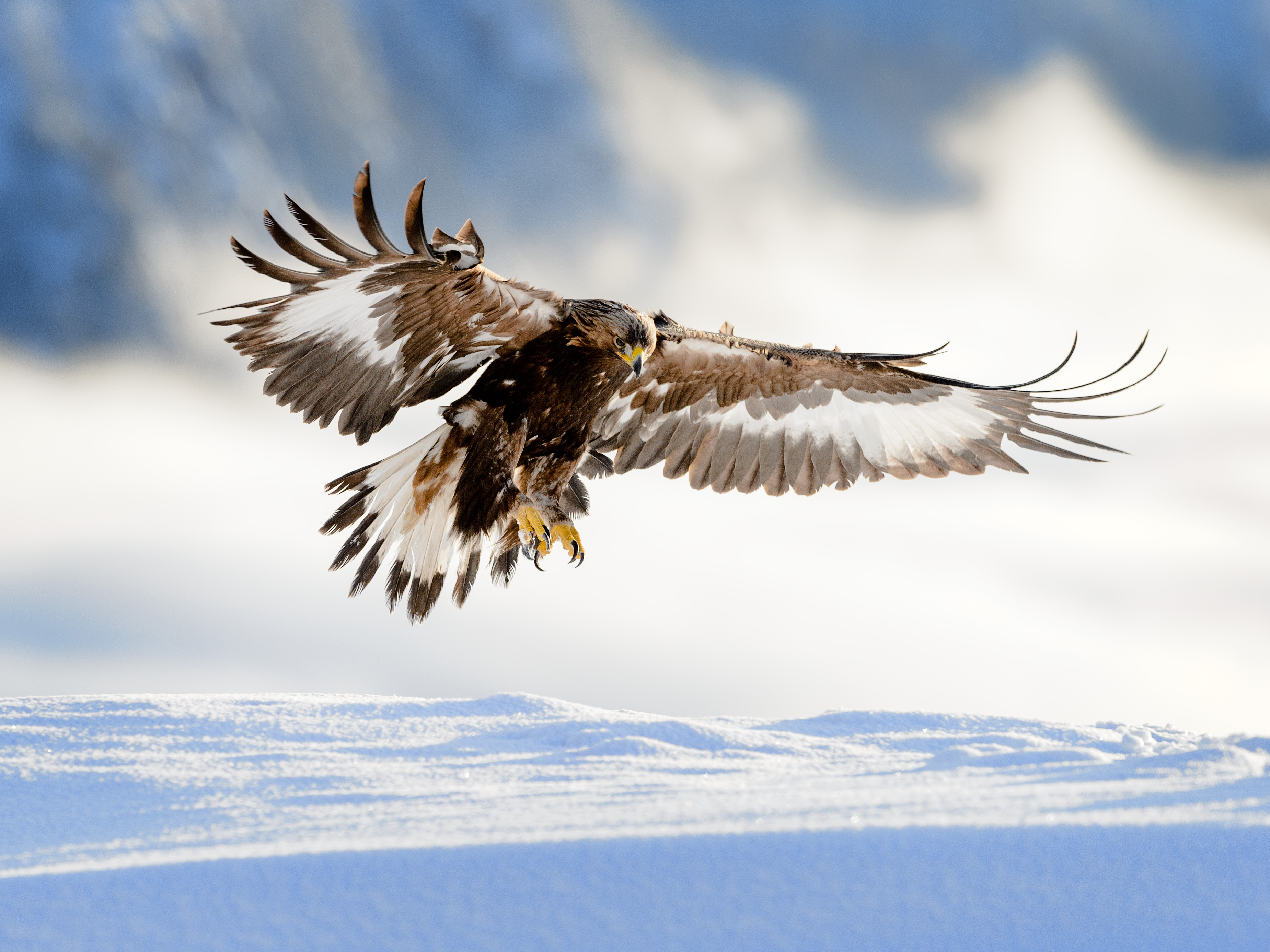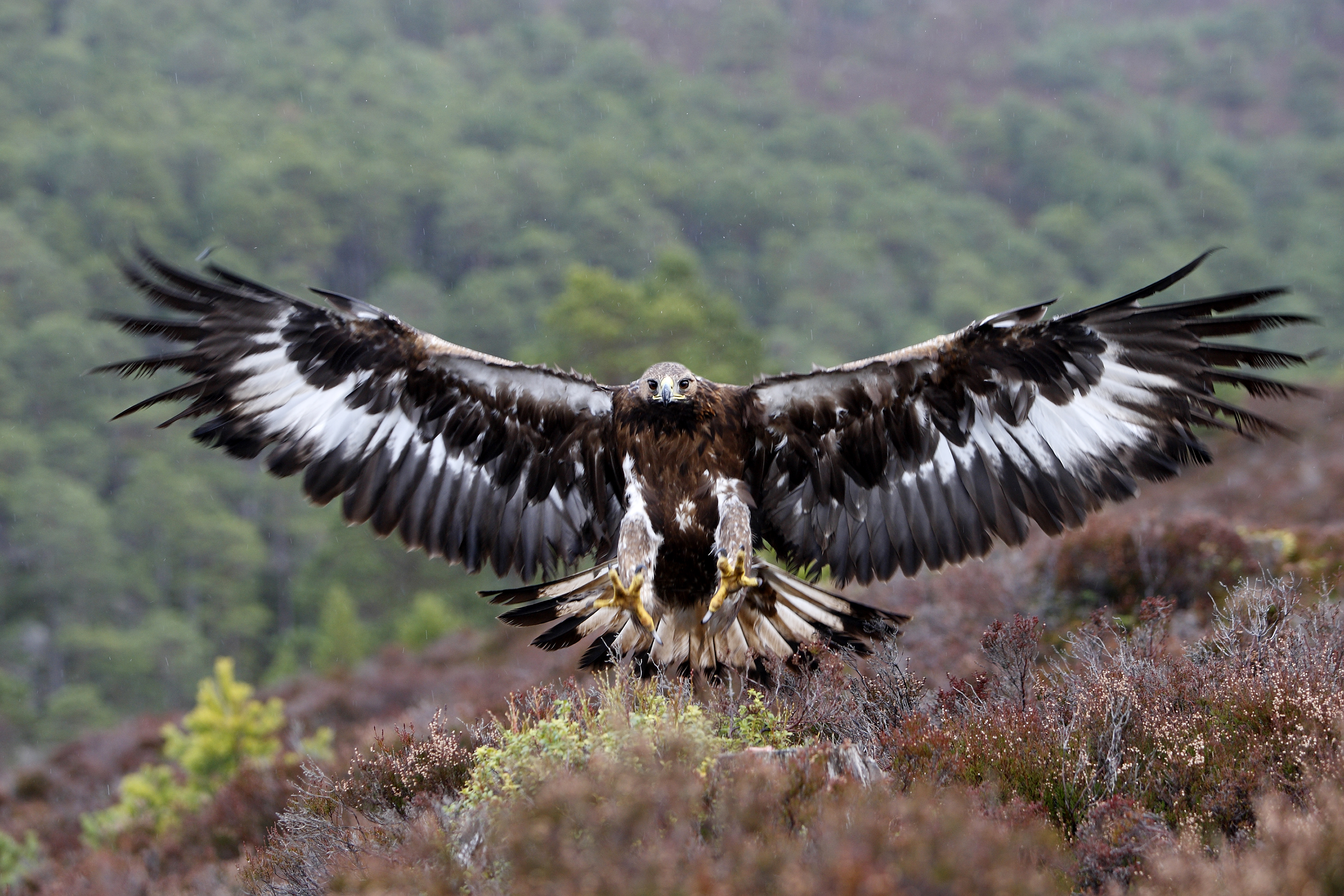Golden Eagles: The aristocrats of the air — magnificent, haughty and deadly
David Profumo admires the golden eagle, the aristocrat of the air.


Although hard to observe in the wild, as a denizen of the high peaks, the golden eagle has entered popular lore as our king of the birds. With its 6ft wingspan and solitary grandeur, it is an emblem of remote magnificence. In 1969, the first lunar words actually spoken by Neil Armstrong were: ‘Houston: Tranquility Base here — the Eagle has landed.’
The golden eagle — Aquila chrysaetos — belongs to the genus of ‘booted eagles’, and is widely distributed across the Alps, Pyrenees, northern Africa and North America. In Britain, it’s effectively confined to the Highlands and islands of Scotland.

Never popular with shepherds or preservers of game birds, it was, in Victorian times, persecuted almost to extinction; we may now have some 450 breeding pairs. In the Gaelic, it is known as the ‘black eagle’ (Iolaire dubh) — and its lustrous tawny shawl does appear dark, unless gilded by sunlight. The plumage is a medley of browns, the thighs thickly trousered with white, the toes an impressive yellow (those talons can exert 15 times the power of a human hand).
With its haughty, raptorial beak and piercing eye — it’s held to be the only bird that can stare directly into the sun — the eagle glides aloft on thermals with little apparent effort or rows through the air with deep strokes, its wings slightly upswept in finger shapes at their tips. It can dive at speeds in excess of 100mph. Only the puppyish way-oh of its voice seems at odds with this majestic physique.
'The playwright Aeschylus was killed when an eagle dropped a tortoise on his bald head, mistaking it for a handy boulder whereon to crack its trophy'
Each pair may require more than 10,000 acres to roam in search of a living, so this aristocrat of the air has always been something of a rara avis. In Scotland, it will prey off grouse, lagomorphs and corvids, occasionally taking deer calves and lambs as carrion. Its lifting prowess is frequently exaggerated — anything heavier than a hare probably requires dismembering.
The hunting flight is a low-level quartering of terrain, with a sudden pounce to the ground rather than any long, screaming stoop. They’re still used by Kyrgyz tribesmen to hunt foxes. It’s a myth that eagles carry off children, but, in places, they do take anything from snakes to hedgehogs — and they can present an indirect danger to humans. The playwright Aeschylus was killed when an eagle dropped a tortoise on his bald head, mistaking it for a handy boulder whereon to crack its trophy.
In captivity, eagles can live for 30 years. Protected in Britain since 1954, they were once trapped, shot and poisoned, and their nests robbed by egg-collectors. In Texas, they were culled with a 12-gauge from light aircraft. Power lines and wind farms can present modern hazards — one Californian study showed more than half the tagged juveniles found dead were the result of blade-strike mortality.
Exquisite houses, the beauty of Nature, and how to get the most from your life, straight to your inbox.
Eagles are generally monogamous, with courtship and pairing commencing as early as December. Exuberant aerial displays — sometimes involving the exchange of objects — are followed by the refurbishment of eyries. Usually located on cliffs and rocky defiles at altitudes of up to 3,000ft, nests are often massive constructions of branches and torn heather, lined with wood rush or juniper — pairs may maintain several sites, varying their tenancy from year to year.
A clutch of 1–3 eggs is laid in about April, with incubation taking 45 days. Aquiline parents can be fiercely defensive: in a small military helicopter, I was once buzzed by a Perthshire eagle, and they’ve been known to attack gliders and other planes. Even in the nest, downy eaglets often battle to the death.
Widely regarded as the Messenger of the Gods, the eagle became a martial symbol that dates back to ancient Hittite carvings; it was adopted by the Roman legions, Charlemagne, Napoleon and the Nazi party (the USA chose its bald variety, to avoid any imperialistic associations). A Scottish Highland chieftain still sports three primary feathers in his bonnet. It remains the standard finial on flagstaffs.

As the emblem of St John the Evangelist — bearer of the word — eagles feature widely in lecterns; indeed, the letter ‘a’ derives from a pictogram of the perching bird, a discovery that helped decode the Rosetta Stone.
Their legendary strength and splendour gave rise to much sympathetic magic, notably among American Indians, to whom they represented the Great Spirit (braves had to prove their courage by fighting off a bear, challenging enemies or suchlike before sporting that war bonnet). Aetites — pebbles filched from eyries — were believed to ease childbirth.
Bronze Age burial sites reveal arrows fletched with eagle feathers to ensure accuracy, and some early Alpinists sewed a tongue into the lapel of their climbing jackets, to survive safely among the crags.
I once asked a Russian helicopter pilot why he had a golden eagle’s breast feather tacked to his dashboard and, shortly thereafter, we survived a serious crash. His lucky talisman remains here on my desk, as I write.
This article first appeared in Country Life in 2013.

Britain’s birds of prey: The Country Life guide to all of the UK’s raptors
Raptors’ supersonic vision, effortless aerial acrobatics and ruthless hunting instinct make them the undisputed masters of the skies, but can

Credit: Alamy Stock Photo
How white-feathered barn owls terrify their prey into submission: 'It’s like a ghost coming on it'
Scientists have found white owls are superior in their hunting ability to their darker counterparts.

Curious Questions: One for sorrow, two for joy – but why are we so superstitious about magpies?
Superstitions swirl around all manner of different birds, but never more so than with magpies. We take a look at
-
 What on earth is the person who comes up with Annabel's otherworldly facade displays on? London's most magical Christmas shop displays
What on earth is the person who comes up with Annabel's otherworldly facade displays on? London's most magical Christmas shop displaysPhotographs by Greg Funnell.
-
 What trees taught me about perfect planting — Alan Titchmarsh
What trees taught me about perfect planting — Alan TitchmarshSense and patience is key to growing healthy trees, as a certain Mr Mackenzie showed a young Alan Titchmarsh
